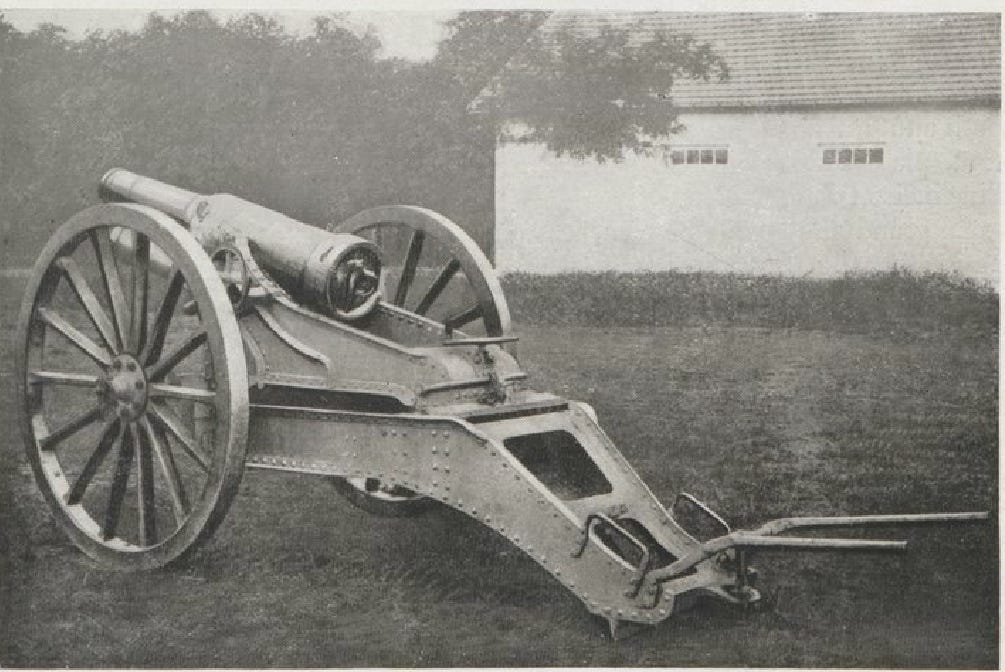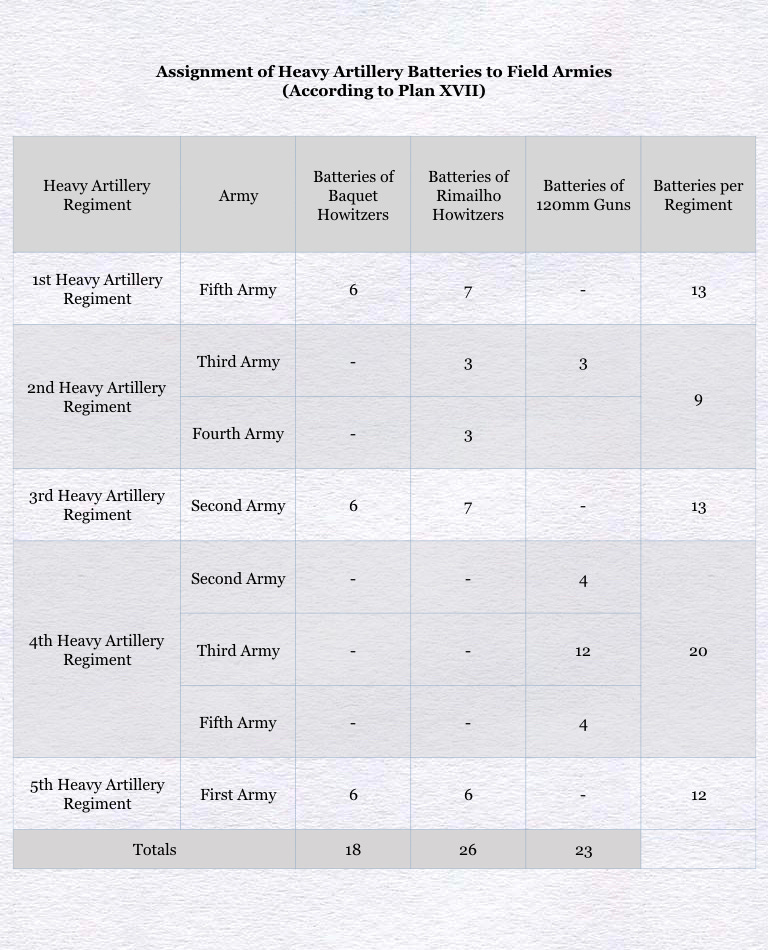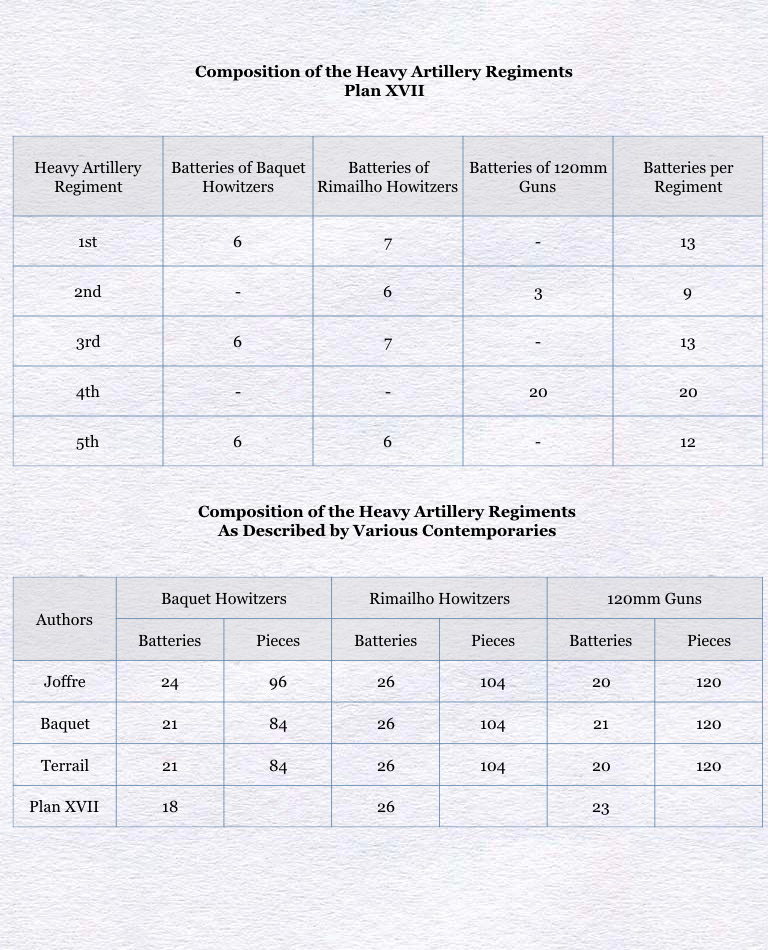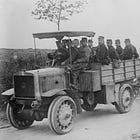At times, the larger questions of history – matters of intent, influence and significance – hinge upon seemingly minor details. Such is the case with the Régiments d’Artillerie Lourde, the five regiments of mobile heavy artillery formed by the French Army on the eve of World War I. At first glance, an exact recreation of the organization of these units, one that establishes the number of batteries in each regiment and the types of artillery pieces issued to those batteries, appears to be a matter of purely antiquarian interest. By the time this enterprise is complete, however, it will become clear that the re-creation of an accurate ‘table of organization and equipment’ for the heavy artillery regiments that took part in the execution of Plan XVII is much more than an exercise in martial bookkeeping.
Promulgated on 7 February 1914, Plan XVII provided the order of battle for the five field armies to be formed at the start of a war with Germany. [1] In doing so, it also provided considerable information about the organization of the mobile heavy artillery that was to be attached to each of those armies. The two largest armies (the Second and Fifth Armies) were each provided with thirteen batteries of howitzers, as well as four batteries of heavy guns. The First Army received twelve batteries of howitzers, but had to borrow its heavy guns from the fortress of Épinal. The eclectic Third Army was allotted six batteries of howitzers and fifteen batteries of heavy guns, while the Fourth Army, which took the prize for the smallest army, made do with just three howitzer batteries.[2]
Because it identifies the regiment to which each battery of mobile heavy artillery belonged, the text of Plan XVII permits the construction of an organizational chart for each of those five units. This exercise uncovers a curious arrangement, one in which the odd-numbered regiments (the 1st, 3rd and 5th Heavy Artillery Regiments) have a more-or-less standard organization and the even-numbered regiments (the 2nd and 4th Heavy Artillery Regiments) have one-of-a-kind structures. In particular, each of the standard regiments consisted of six or seven batteries of 155mm Rimailho howitzers and six batteries of the somewhat lighter 120mm Baquet howitzers. The 2nd Heavy Artillery Regiment, which was smaller than a standard regiment, had six batteries of Rimailho howitzers and three batteries of 120mm de Bange heavy guns. The 4th Heavy Artillery Regiment, which was much larger than a standard regiment, had twenty batteries of the aforementioned 120mm de Bange guns.
The construction of organizational charts also uncovers an anomaly. Though the 2nd Heavy Artillery Regiment consisted of only nine batteries, the text of Plan XVII describes the six batteries from that regiment which were assigned to the Third Army as ‘half of the 2nd Regiment’ (moitié du 2ème Régiment). Consulting memoirs that touch upon the issue of heavy artillery – those of General Joseph Joffre, General Louis Baquet and the parliamentary deputy Gabriel Terrail – does nothing to resolve this issue. [3] While the memoirs agree with Plan XVII in the matter of Rimailho howitzers, they differ, with each other as well as with Plan XVII, where other weapons are concerned.[4]
[1] Verbatim copies of Plan XVII can be found in Fernand Engerand, La Bataille de la Frontière, (Paris: Editions Bossard, 1920), Annex III, pages 191-199 and Les Armées Françaises dans la Grande Guerre (Paris: Imprimerie Nationale, 1924), Tome I, Volume 1, Annex 8, pages 21-30.
[2] A ‘battery’ was an artillery unit that consisted of four or six artillery pieces, the gunners who served them and, unless the unit was of the sedentary or motorized variety, the horses needed to move those artillery pieces from one place to another.
[3] Joseph Joffre, Mémoires du Général Joffre, (Paris: Librarie Plon, 1932), page 71; Louis Baquet, Souvenirs d’un Directeur d’Artillerie, (Paris: Charles-Lavauzelle, 1921), pages 118-19; Gabriel Mermeix, Au Sein des Commissions, (Paris: Librarie Ollendorff, 1924), page 286. Gabriel Mermeix was the nom de plume of Gabriel Terrail (1859-1930), a French journalist and member of the Chamber of Deputies of the French parliament. Louis Baquet (1858-1923) was the director of artillery at the French war ministry during the winter and spring of 1915. He was also the eponymous inventor of the 120mm Baquet howitzer that plays such a large role in this article.
[4] There are internal inconsistencies with the figures provided by Joffre, who allocates his ninety-six Baquet howitzers into fifteen batteries. As dividing ninety-six by fifteen yields neither four-piece batteries nor six-piece batteries, Joffre’s figure of fifteen batteries of Baquet howitzers is clearly a slip of the pen. Baquet explains that his figures assume eighteen six-piece 120mm gun batteries and three four-piece 120mm gun batteries. (The latter three batteries were the three motorized batteries of the 4th Heavy Artillery Regiment.)
This is the first post in The Phantom Batteries of Plan XVII. For links to the other posts in this series, please make use of the following aggregator:
To Subscribe, Support, or Share:









